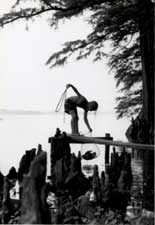How We Connect with the Earth
|
This article originally appeared in Issue# 51
|
It takes only one summer for a child of the right age to bond with the natural world, to know in her bones that the world is alive, and wild and kin to her. There is a kind of imprinting that either takes place, or doesn't, in a girl or boy before the age of 10 or 11.
As long as the wilderness survives, there is a place for this bonding to occur. As long as there are unspoiled natural places near enough that we can reach them and spend enough time in them, our children can have that inner awakening and sense of connection.
But it can never happen through media. Television's nature programs are wonderful. They must continue. They are probably the most important programming produced in our time. But we humans cannot form that essential bond through the tube.
The majesty, the power, the presence of a world uncreated by humans and uncorrupted by them cannot be reduced to the size of a TV screen, or glossy photographs in beautiful magazines, not even to a wrap-around Omni theater. Something essential is stripped from nature when it comes as a mediated image instead of a direct encounter.
When, for the first time, a nine-year-old barefoot boy and a wild crawfish encounter each other by surprise in a cold spring creek, there is nothing like it in the world. The boy's life is changed. And if he explores this watery world and the woods that surround it for the length of a long summer, he will have taken the whole ancient biosphere into his soul, never to be forgotten. The imprint is for a lifetime.
But if those imprintable years are allowed to pass for a boy or girl with only vicarious, mediated experience of nature, it is likely that as adults they will never be able to understand why a mountain forest is anything more than a pretty scene for a postcard or potential boardfeet or pulpwood for the commodities market.



